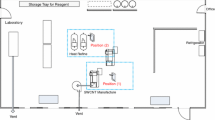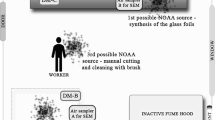Abstract
Nanotechnology gives us materials with enhanced or completely new properties. At the same time, inhalation of manufactured nano-objects has been related to an array of adverse biological effects. We characterized particle emissions, which occurred during maintenance of common metal nanoparticle generators and contrasted the properties of the emitted particles with those originally produced by the generators. A new approach using online aerosol mass spectrometry (AMS), for time- and size-resolved measurements of the particle chemical composition, was applied in combination with more conventional techniques for particle sampling and analysis, including electron microscopy. Emissions during maintenance work, in terms of mass and surface area concentration in the size range of 0.02–10 μm, were dominated by large agglomerates (1–5 μm). With AMS, we show that the particle composition depends on both generator type and maintenance task being performed and that the instrument can be used for highly time-resolved selective studies of metal nanoparticle emissions. The emitted agglomerates have a relatively high probability to be deposited in the lower respiratory tract, since the mean particle diameter coincided with a peak in the lung deposition curve. Each of these agglomerates consisted of a very high number (103–105/agglomerate) of nanometer-sized primary particles originating from the particle synthesis process. This made them possess large surface areas, one of the key properties in nanotoxicology. Similar agglomerates may be emitted in a wide range of processes when nanoparticles are manufactured or handled. The fate of such agglomerates, once deposited in the respiratory tract, is unknown and should therefore be considered in future particle toxicological studies. Our results highlight the importance of including micrometer-sized particles in exposure and emission assessments.






Similar content being viewed by others
References
Abbott LC, Maynard AD (2010) Exposure assessment approaches for engineered nanomaterials. Risk Anal 30(11):1634–1644. doi:10.1111/j.1539-6924.2010.01446.x
Alvarez PJJ, Colvin V, Lead J, Stone V (2009) Research priorities to advance eco-responsible nanotechnology. ACS Nano 3(7):1616–1619. doi:10.1021/Nn9006835
Anjilvel S, Asgharian B (1995) A multiple-path model of particle deposition in the rat lung. Fundam Appl Toxicol 28(1):41–50. doi:10.1006/faat.1995.1144
Asbach C, Fissan H, Stahlmecke B, Kuhlbusch TAJ, Pui DYH (2009) Conceptual limitations and extensions of lung-deposited Nanoparticle Surface Area Monitor (NSAM). J Nanopart Res 11(1):101–109. doi:10.1007/s11051-008-9479-8
Asbach C, Kaminski H, Von Barany D, Kuhlbusch TAJ, Monz C, Dziurowitz N, Pelzer J, Vossen K, Berlin K, Dietrich S, Gotz U, Kiesling HJ, Schierl R, Dahmann D (2012) Comparability of portable nanoparticle exposure monitors. Ann Occup Hyg 56(5):606–621. doi:10.1093/annhyg/mes033
Baron PA, Willeke K (2001) Aerosol measurement: principles, techniques and applications, 2nd edn. Wiley, New York
Bello D, Wardle BL, Yamamoto N, de Villoria RG, Garcia EJ, Hart AJ, Ahn K, Ellenbecker MJ, Hallock M (2009) Exposure to nanoscale particles and fibers during machining of hybrid advanced composites containing carbon nanotubes. J Nanopart Res 11(1):231–249. doi:10.1007/s11051-008-9499-4
Biskos G, Schmidt-Ott A (2012) Airborne engineered nanoparticles: potential risks and monitoring challenges for assessing their impacts on children. Paediatr Respir Rev 13(2):79–83. doi:10.1016/j.prrv.2011.05.011
Bohgard M, Jangida BL, Akselsson KR (1979) Analytical procedure for determining chromium in samples of airborne dust. Ann Occup Hyg 22(3):241–251. doi:10.1093/annhyg/22.3.241
Canagaratna MR, Jayne JT, Jimenez JL, Allan JD, Alfarra MR, Zhang Q, Onasch TB, Drewnick F, Coe H, Middlebrook A, Delia A, Williams LR, Trimborn AM, Northway MJ, DeCarlo PF, Kolb CE, Davidovits P, Worsnop DR (2007) Chemical and microphysical characterization of ambient aerosols with the aerodyne aerosol mass spectrometer. Mass Spectrom Rev 26(2):185–222. doi:10.1002/Mas.20115
Cedervall T, Lynch I, Lindman S, Berggard T, Thulin E, Nilsson H, Dawson KA, Linse S (2007) Understanding the nanoparticle–protein corona using methods to quantify exchange rates and affinities of proteins for nanoparticles. Proc Natl Acad Sci USA 104(7):2050–2055. doi:10.1073/pnas.0608582104
Cross ES, Onasch TB, Canagaratna M, Jayne JT, Kimmel J, Yu XY, Alexander ML, Worsnop DR, Davidovits P (2009) Single particle characterization using a light scattering module coupled to a time-of-flight aerosol mass spectrometer. Atmos Chem Phys 9(20):7769–7793
Cross ES, Sappok A, Fortner EC, Hunter JF, Jayne JT, Brooks WA, Onasch TB, Wong VW, Trimborn A, Worsnop DR, Kroll JH (2012) Real-time measurements of engine-out trace elements: application of a novel soot particle aerosol mass spectrometer for emissions characterization. J Eng Gas Turbines Power 134(7):072801. doi:10.1115/1.4005992
Dahm MM, Evans DE, Schubauer-Berigan MK, Birch ME, Deddens JA (2012) Occupational exposure assessment in carbon nanotube and nanofiber primary and secondary manufacturers: mobile direct-reading sampling. Ann Occup Hyg 53:1–17
Demou E, Stark WJ, Hellweg S (2009) Particle emission and exposure during nanoparticle synthesis in research laboratories. Ann Occup Hyg 53(8):829–838. doi:10.1093/annhyg/mep061
Elder A, Gelein R, Silva V, Feikert T, Opanashuk L, Carter J, Potter R, Maynard A, Finkelstein J, Oberdorster G (2006) Translocation of inhaled ultrafine manganese oxide particles to the central nervous system. Environ Health Persp 114(8):1172–1178. doi:10.1289/Ehp.9030
Evans DE, Turkevich LA, Roettgers CT, Deye GJ, Baron PA (2013) Dustiness of fine and nanoscale powders. Ann Occup Hyg 57(2):261–277. doi:10.1093/annhyg/mes060
Heurlin M, Magnusson MH, Lindgren D, Ek M, Wallenberg LR, Deppert K, Samuelson L (2012) Continuous gas-phase synthesis of nanowires with tunable properties. Nature 492(7427):90–94. doi:10.1038/Nature11652
Hinds WC (1999) Aerosol technology: properties, behavior and measurements of airborne particles, 2nd edn. Wiley, New York
Jayne JT, Leard DC, Zhang XF, Davidovits P, Smith KA, Kolb CE, Worsnop DR (2000) Development of an aerosol mass spectrometer for size and composition analysis of submicron particles. Aerosol Sci Technol 33(1–2):49–70
Jimenez JL, Jayne JT, Shi Q, Kolb CE, Worsnop DR, Yourshaw I, Seinfeld JH, Flagan RC, Zhang XF, Smith KA, Morris JW, Davidovits P (2003) Ambient aerosol sampling using the Aerodyne Aerosol Mass Spectrometer. J Geophys Res Atmos 108(D7):8425. doi:10.1029/2001jd001213
Johnson DR, Methner MM, Kennedy AJ, Steevens JA (2010) Potential for occupational exposure to engineered carbon-based nanomaterials in environmental laboratory studies. Environ Health Perspect 118(1):49–54. doi:10.1289/Ehp.0901076
Koivisto AJ, Aromaa M, Makela JM, Pasanen P, Hussein T, Hameri K (2012a) Concept to estimate regional inhalation dose of industrially synthesized nanoparticles. ACS Nano 6(2):1195–1203. doi:10.1021/Nn203857p
Koivisto AJ, Lyyranen J, Auvinen A, Vanhala E, Hameri K, Tuomi T, Jokiniemi J (2012b) Industrial worker exposure to airborne particles during the packing of pigment and nanoscale titanium dioxide. Inhalation Toxicol 24(12):839–849. doi:10.3109/08958378.2012.724474
Kuhlbusch TAJ, Asbach C, Fissan H, Gohler D, Stintz M (2011) Nanoparticle exposure at nanotechnology workplaces: a review. Part Fibre Toxicol 8:22. doi:10.1186/1743-8977-8-22
Lee J, Mahendra S, Alvarez PJJ (2010) Nanomaterials in the construction industry: a review of their applications and environmental health and safety considerations. ACS Nano 4(7):3580–3590. doi:10.1021/Nn100866w
Maynard AD, Aitken RJ, Butz T, Colvin V, Donaldson K, Oberdorster G, Philbert MA, Ryan J, Seaton A, Stone V, Tinkle SS, Tran L, Walker NJ, Warheit DB (2006) Safe handling of nanotechnology. Nature 444(7117):267–269. doi:10.1038/444267a
Messing ME, Dick KA, Wallenberg LR, Deppert K (2009) Generation of size-selected gold nanoparticles by spark discharge—for growth of epitaxial nanowires. Gold Bull 42(1):20–26
Messing ME, Svensson CR, Pagels J, Meuller BO, Deppert K, Rissler J (2013) Gas-borne particles with tunable and highly controlled characteristics for nanotoxicology studies. Nanotoxicology 7(6):1052–1063. doi: 10.3109/17435390.2012.697589
Methner M, Hodson L, Dames A, Geraci C (2010a) Nanoparticle emission assessment technique (NEAT) for the identification and measurement of potential inhalation exposure to engineered nanomaterials. Part B. Results from 12 field studies. J Occup Environ Hyg 7(3):163–176. doi:10.1080/15459620903508066
Methner M, Hodson L, Geraci C (2010b) Nanoparticle emission assessment technique (NEAT) for the identification and measurement of potential inhalation exposure to engineered nanomaterials. Part A. J Occup Environ Hyg 7(3):127–132. doi:10.1080/15459620903476355
Oberdorster G (2000) Toxicology of ultrafine particles: in vivo studies. Philos Trans R Soc A 358(1775):2719–2739. doi:10.1098/rsta.2000.0680
Oberdorster G, Sharp Z, Atudorei V, Elder A, Gelein R, Kreyling W, Cox C (2004) Translocation of inhaled ultrafine particles to the brain. Inhalation Toxicol 16(6–7):437–445. doi:10.1080/08958370490439597
Onasch TB, Trimborn A, Fortner EC, Jayne JT, Kok GL, Williams LR, Davidovits P, Worsnop DR (2012) Soot particle aerosol mass spectrometer: development, validation, and initial application. Aerosol Sci Technol 46(7):804–817. doi:10.1080/02786826.2012.663948
Pagels J, Gudmundsson A, Gustavsson E, Asking L, Bohgard M (2005) Evaluation of aerodynamic particle sizer and electrical low-pressure impactor for unimodal and bimodal mass-weighted size distributions. Aerosol Sci Technol 39(9):871–887. doi:10.1080/02786820500295677
Park K, Dutcher D, Emery M, Pagels J, Sakurai H, Scheckman J, Qian S, Stolzenburg MR, Wang X, Yang J, McMurry PH (2008) Tandem measurements of aerosol properties—a review of mobility techniques with extensions. Aerosol Sci Technol 42(10):801–816. doi:10.1080/02786820802339561
Park J, Kwak BK, Bae E, Lee J, Choi K, Yi J, Kim Y (2009a) Exposure assessment of engineered nanomaterials in the workplace. Korean J Chem Eng 26(6):1630–1636. doi:10.1007/s11814-009-0238-z
Park J, Kwak BK, Bae E, Lee J, Kim Y, Choi K, Yi J (2009b) Characterization of exposure to silver nanoparticles in a manufacturing facility. J Nanopart Res 11(7):1705–1712. doi:10.1007/s11051-009-9725-8
Peters TM, Elzey S, Johnson R, Park H, Grassian VH, Maher T, O’Shaughnessy P (2009) Airborne monitoring to distinguish engineered nanomaterials from incidental particles for environmental health and safety. J Occup Environ Hyg 6(2):73–81. doi:10.1080/15459620802590058
Poschl U, Martin ST, Sinha B, Chen Q, Gunthe SS, Huffman JA, Borrmann S, Farmer DK, Garland RM, Helas G, Jimenez JL, King SM, Manzi A, Mikhailov E, Pauliquevis T, Petters MD, Prenni AJ, Roldin P, Rose D, Schneider J, Su H, Zorn SR, Artaxo P, Andreae MO (2010) Rainforest aerosols as biogenic nuclei of clouds and precipitation in the amazon. Science 329(5998):1513–1516. doi:10.1126/science.1191056
Rissler J, Swietlicki E, Bengtsson A, Boman C, Pagels J, Sandstrom T, Blomberg A, Londahl J (2012) Experimental determination of deposition of diesel exhaust particles in the human respiratory tract. J Aerosol Sci 48:18–33. doi:10.1016/j.jaerosci.2012.01.005
Rivera Gil P, Oberdorster G, Elder A, Puntes V, Parak WJ (2010) Correlating physico-chemical with toxicological properties of nanoparticles: the present and the future. ACS Nano 4(10):5527–5531. doi:10.1021/Nn1025687
Savi M, Kalberer M, Lang D, Ryser M, Fierz M, Gaschen A, Ricka J, Geiser M (2008) A novel exposure system for the efficient and controlled deposition of aerosol particles onto cell cultures. Environ Sci Technol 42(15):5667–5674. doi:10.1021/Es703075q
Schmid O, Moller W, Semmler-Behnke M, Ferron GA, Karg E, Lipka J, Schulz H, Kreyling WG, Stoeger T (2009) Dosimetry and toxicology of inhaled ultrafine particles. Biomarkers 14:67–73. doi:10.1080/13547500902965617
Seaton A, Donaldson K (2005) Nanoscience, nanotoxicology, and the need to think small. Lancet 365(9463):923–924
Seipenbusch M, Toneva P, Peukert W, Weber AP (2007) Impact fragmentation of metal nanoparticle agglomerates. Part Part Syst Charact 24(3):193–200. doi:10.1002/ppsc.200601089
Seipenbusch M, Rothenbacher S, Kirchhoff M, Schmid HJ, Kasper G, Weber AP (2010) Interparticle forces in silica nanoparticle agglomerates. J Nanopart Res 12(6):2037–2044. doi:10.1007/s11051-009-9760-5
Sorensen CM (2011) The mobility of fractal aggregates: a review. Aerosol Sci Technol 45(7):765–779. doi:10.1080/02786826.2011.560909
Stebounova LV, Morgan H, Grassian VH, Brenner S (2012) Health and safety implications of occupational exposure to engineered nanomaterials. Wires Nanomed Nanobiotechnol 4(3):310–321. doi:10.1002/Wnan.174
Tsai CJ, Huang CY, Chen SC, Ho CE, Huang CH, Chen CW, Chang CP, Tsai SJ, Ellenbecker MJ (2011) Exposure assessment of nano-sized and respirable particles at different workplaces. J Nanopart Res 13(9):4161–4172. doi:10.1007/s11051-011-0361-8
Wong BA, Nash DG, Moss OR (2009) Generation of nanoparticle agglomerates and their dispersion in lung serum simulant or water. J Phys Conf Ser 151:012036. doi:10.1088/1742-6596/151/1/012036
Woskie S (2010) Workplace practices for engineered nanomaterial manufacturers. Wires Nanomed Nanobiotechnol 2(6):685–692. doi:10.1002/Wnan.101
Yli-Ojanpera J, Sakurai H, Iida K, Makela JM, Ehara K, Keskinen J (2012) Comparison of three particle number concentration calibration standards through calibration of a single CPC in a wide particle size range. Aerosol Sci Technol 46(11):1163–1173. doi:10.1080/02786826.2012.701023
Zimmermann E, Derrough S, Locatelli D, Durand C, Fromaget JL, Lefranc E, Ravanel X, Garrione J (2012) Results of potential exposure assessments during the maintenance and cleanout of deposition equipment. J Nanopart Res 14(10):1209. doi:10.1007/S11051-012-1209-6
Acknowledgments
The authors acknowledge the Swedish Research Council (FAS), Grant no. 2009-1291, the Nanometer Structure Consortium at Lund University (nmC@LU), and the FAS-center METALUND for supplying the funding. The European Commission 7th Framework Programme (NANoREG), Grant Agreement Number 310584, is also acknowledged.
Author information
Authors and Affiliations
Corresponding author
Electronic supplementary material
Below is the link to the electronic supplementary material.
Rights and permissions
About this article
Cite this article
Nilsson, P.T., Isaxon, C., Eriksson, A.C. et al. Nano-objects emitted during maintenance of common particle generators: direct chemical characterization with aerosol mass spectrometry and implications for risk assessments. J Nanopart Res 15, 2052 (2013). https://doi.org/10.1007/s11051-013-2052-0
Received:
Accepted:
Published:
DOI: https://doi.org/10.1007/s11051-013-2052-0




